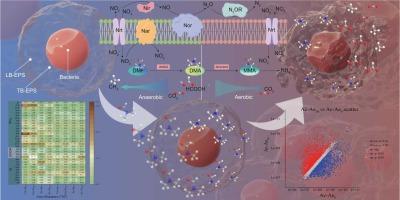元基因组学和元蛋白组学揭示污泥类型和接种模式对 N,N-二甲基甲酰胺降解途径和相关微生物群落的影响
IF 12.2
1区 环境科学与生态学
Q1 ENGINEERING, ENVIRONMENTAL
引用次数: 0
摘要
这项研究证明了污泥类型和接种方法对 N,N-二甲基甲酰胺降解途径和相关微生物群落的影响。污泥类型对DMF代谢至关重要,适应性好氧污泥在DMF代谢性能方面具有显著优势,而适应性厌氧污泥则降低了DMF代谢能力。元基因组显示,适应性厌氧污泥中 Methanosarcina、Pelomona 和 Xanthobacter 的丰度增加,表明厌氧污泥可以利用 DMF 代谢产生的甲基产物进行生长。适应性好氧污泥中的分枝杆菌数量较多,大大促进了 DMF 的水解。此外,在好氧污泥中发现了大量 dmfA2 基因,在适应性污泥中发现的更多,这表明 DMF 代谢更强。相反,适应性厌氧污泥中的 dmd-tmd 和 mauA/B, qhpA 基因丰度较低,这意味着长期的 DMF 毒性降低了厌氧微生物的活性。元蛋白组分析表明,厌氧污泥中的 Methanosarcina 和 Methanomethylovorans 酶可将二甲胺和甲胺代谢为甲烷,从而帮助降解 DMF。在好氧污泥中,水解 DMF 的氨水解酶蛋白明显上调。这些发现为 DMF 废水处理提供了启示。本文章由计算机程序翻译,如有差异,请以英文原文为准。

Metagenomics and metaproteomics reveal the effects of sludge types and inoculation modes on N,N-dimethylformamide degradation pathways and the microbial community involved
This study demonstrated the effects of the sludge type and inoculation method on the N,N-dimethylformamide degradation pathway and associated microbial communities. The sludge type is critical for DMF metabolism, with acclimatized aerobic sludge having a significant advantage in terms of DMF metabolism performance, whereas acclimatized anaerobic sludge has a reduced DMF metabolism capacity. Metagenomic revealed increased abundances of Methanosarcina, Pelomona and Xanthobacter in the adapted anaerobic sludge, suggesting that anaerobic sludge can utilize the methyl products produced by DMF metabolism for growth. Adapted aerobic sludge had high Mycobacterium abundance, significantly boosting DMF hydrolysis. In addition, a large number of dmfA2 genes were found in aerobic sludge, more so in acclimatized sludge, indicating stronger DMF metabolism. Conversely, acclimatized anaerobic sludge showed lower abundance of dmd-tmd and mauA/B, qhpA genes, implying long-term DMF toxicity reduced anaerobic microbial activity. Metaproteomic analysis showed that Methanosarcina and Methanomethylovorans enzymes in anaerobic sludge metabolized dimethylamine and methylamine to methane, aiding DMF degradation. In the aerobic sludge, aminohydrolase proteins, which hydrolyze DMF, were significantly upregulated. These findings provide insights into DMF wastewater treatment.
求助全文
通过发布文献求助,成功后即可免费获取论文全文。
去求助
来源期刊

Journal of Hazardous Materials
工程技术-工程:环境
CiteScore
25.40
自引率
5.90%
发文量
3059
审稿时长
58 days
期刊介绍:
The Journal of Hazardous Materials serves as a global platform for promoting cutting-edge research in the field of Environmental Science and Engineering. Our publication features a wide range of articles, including full-length research papers, review articles, and perspectives, with the aim of enhancing our understanding of the dangers and risks associated with various materials concerning public health and the environment. It is important to note that the term "environmental contaminants" refers specifically to substances that pose hazardous effects through contamination, while excluding those that do not have such impacts on the environment or human health. Moreover, we emphasize the distinction between wastes and hazardous materials in order to provide further clarity on the scope of the journal. We have a keen interest in exploring specific compounds and microbial agents that have adverse effects on the environment.
 求助内容:
求助内容: 应助结果提醒方式:
应助结果提醒方式:


